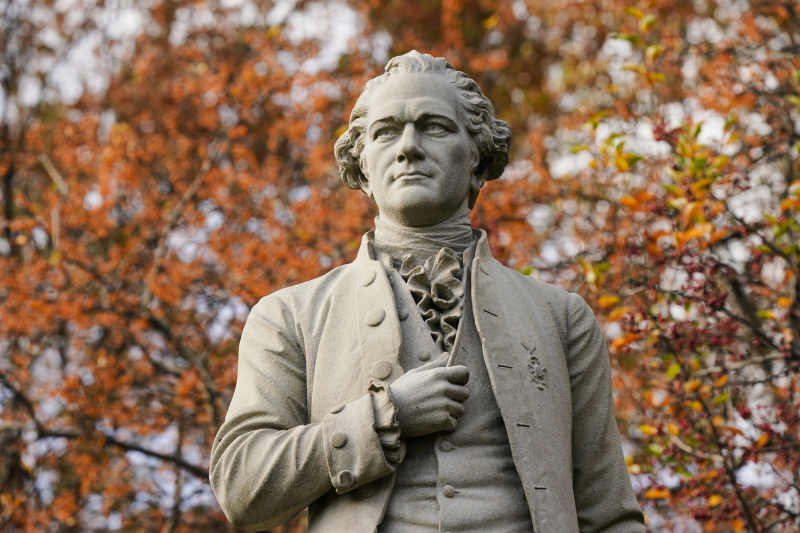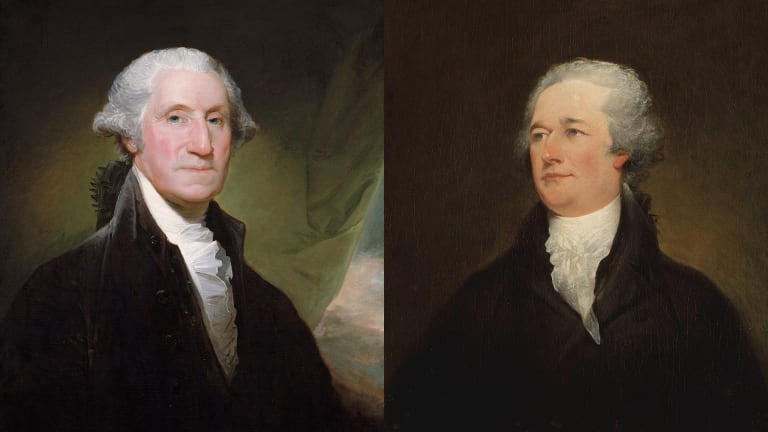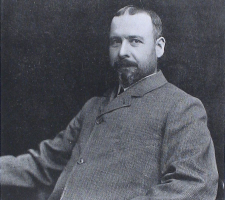Top 10 Interesting Facts about Alexander Hamilton
Alexander Hamilton, the star of one of the greatest musicals ever, was a crucial founding father of the United States of America. In addition to being a member ... read more...of the Continental Congress with enormous influence, he wrote The Federalist Papers and supported the U.S. Constitution. Since then, Hamilton's fascinating life and accomplishments have come to the forefront thanks to Lin-Manuel Miranda's Broadway production. The American statesman, politician, legal scholar, military commander, lawyer, banker, and economist is the subject of the following 10 interesting facts about Alexander Hamilton below.
-
Alexander Hamilton was born on January 11 on the Caribbean island of Nevis, the illegitimate son of a Scottish immigrant father and a British West Indian mother (who just so happened to be married to someone else). Despite official records from Nevis stating that Hamilton was born in 1755, Hamilton himself claimed to have been born in 1757. Although there has been disagreement over this disparity for more than two centuries, the majority of contemporary experts concur that Hamilton most certainly changed his birth year on purpose, which is one of the most interesting facts about Alexander Hamilton.
James, Hamilton's father, left the family soon after Hamilton was born out of concern that the child's mother would be accused of bigamy. Hamilton's mother passed away in 1768, when he was probably 13 years old, making him essentially an orphan. He would have been a more appealing candidate for an apprenticeship with a local businessman if he had cut two years off his age. If Hamilton intended this, it was successful because he was swiftly hired by an import-export company and made an impression on his superiors. They chose to send Hamilton to the American colonies in 1772 so he could continue his schooling there. Hamilton maintained the charade, arriving in his new country at the self-declared age of 15, and entered politics right away. His perceived precociousness only served to solidify his reputation as a political prodigy.

Photo: https://www.history.com/ 
Photo: https://www.timeforkids.com/ -
National political parties came into being as a result of the conflict over Hamilton's program and foreign policy difficulties. Hamilton, like Washington, had disliked gatherings and associated them with chaos and instability. He had planned to create a higher class of people who would rule over the party. Nevertheless, he rose to become the head of the Federalist Party, a group of politicians whose main goal was to back his policies. To get his proposal through Congress, Hamilton established himself as the leader of that party. He did this because he needed organized political backing and effective executive branch leadership. The Republican Party (later Democratic-Republican Party), founded by House of Representatives member James Madison and Secretary of State Thomas Jefferson, was the political force that opposed the Hamiltonians. The Federalists favored maintaining tight links with England while the Republicans desired to fortify the country's historic ties to France.
Hamilton intruded on Jefferson's purview of international affairs to carry out his plan. He fought against Jefferson's foreign policy initiatives that may benefit France or harm England because he despised the French Revolution and the egalitarian ideals it gave rise to. He also attempted to persuade Washington to adopt his thoughts on foreign policy. In terms of foreign policy, Hamilton even went so far as to caution British officials about Jefferson's allegiance to France and advise them to work directly with the president and himself rather than the secretary of state. Jefferson and Hamilton got into a fight over this and other aspects of Hamilton's plan, and they both tried to remove the other from the cabinet.

Photo: https://potus-geeks.livejournal.com/ 
Photo: https://www.history.com/ -
The young Philadelphian Maria Reynolds claimed she needed money because her husband had abandoned her with a young daughter to raise when she met the married Hamilton in 1791. Hamilton, who was ready to comply despite being an orphan himself, found their financial arrangement to be more complicated when they began an affair that would last just over a year. Maria Reynolds, though, wasn't a desperate housewife. She and her husband, James, had meticulously planned the affair to coerce Secretary Hamilton, who gladly handed over the money, into paying even more.
James Reynolds revealed to the investigators—a team that included James Monroe and Frederick Muhlenberg—that Hamilton had been using government monies as hush money after he was named in another financial scam. When asked about this, Hamilton acknowledged having an affair but said that he had spent all of his money to hide it. He even provided Monroe with his love letters from Maria Reynolds as evidence. Monroe and Muhlenberg decided not to reveal Hamilton's identity after being assured that this was a private affair. However, Monroe delivered the letters to Thomas Jefferson, a personal friend and one of Hamilton's most ferocious political rivals. James Callender, a publisher who was already well-known for being the top purveyor of political rumors in the 19th century, received them from Jefferson.
After Callender published the Reynolds-Hamilton letters in his periodical in 1797, the scandal erupted. Hamilton went on the attack, more worried about how the accusations of misusing public monies would harm him politically than how the revelation would damage his family. In his lengthy pamphlet, which was published, he acknowledged the extramarital affair. Although Hamilton's integrity was praised in public, his political career was essentially wrecked.

Photo: https://www.history.com/ 
Maria Reynolds - Photo: https://www.history.com/ -
One of the most interesting facts about Alexander Hamilton is he and his eldest son were killed under similar circumstances and in the same location. In one of the most well-known duels in American history, Vice President Aaron Burr shot and mortally wounded Alexander Hamilton on July 11, 1804. Even though this was Hamilton's first—and final—duel, the sport was nothing new to him. Being one of the most controversial and aggressive figures of his time, he had already accepted invitations to about a dozen duels throughout his life but had always avoided engaging in battle.
Philip, his oldest son, was less fortunate. Philip, then 19 years old, met New York attorney George Eacker in 1801, after hearing a speech that disparaged his father, and he demanded an apology. A duel in Weehawken, New Jersey, was scheduled on November 20 when Eacker rejected it. Eacker was unharmed, but Philip passed away the next day in agony. The tragedy saddened the Hamilton family, and many historians think that three years later, when they famously dueled, Hamilton was reluctant to shoot directly at Aaron Burr because of it. Hamilton, for whatever reason, missed his opponent but was immediately shot in the stomach; he died the following day.

Photo: https://www.wearethemighty.com/ 
Photo: https://www.history.com/ -
Hamilton and Burr were two of the finest attorneys in post-World War II Manhattan. The two decorated warriors attracted clients, and Hamilton and Burr engaged in numerous legal battles. They occasionally collaborated on the same criminal or civil case, such as People v. Levi Weeks (1800), which is regarded as the earliest murder trial in the United States for which we have a written record.
Gulielma Sands, a young woman, unexpectedly disappeared in December 1799. Her remains were discovered at the bottom of a Manhattan well eleven days later. A suspect was named the carpenter Levi Weeks, who had been pursuing Sands and shared a boarding home with her.
People believed Weeks was guilty. Fortunately for the carpenter, though, Hamilton's Convent Avenue estate had been built under the supervision of his architect older brother Ezra. Ezra had also conducted business with the Manhattan Company, which was established by Burr and, coincidentally, owned the well where Sands's body was discovered.
Weeks' legal team consisted of Burr, Hamilton, and Brockholst Livingston, who later rose to the rank of Associate Justice on the U.S. Supreme Court. They deconstructed the state's mainly circumstantial case against their client during the two-day trial, and the carpenter was declared not guilty. Weeks eventually relocated to Natchez, Mississippi, and remade himself as a renowned architect in the South.

Photo: https://www.biography.com/ 
Photo: https://pixels.com/ -
Except for brief assignments in the military and government, Alexander Hamilton made New York City his home for the remainder of his life. Compared to other founding fathers, Hamilton did more to advance and defend the interests of New York. He and his expanding family, which eventually numbered eight children, resided in several rented residences in lower Manhattan for a considerable amount of time. Hamilton bought a 32-acre plot of land in modern-day Harlem, which at the time was regarded as a rural suburb of New York, after leaving the government in 1795. In commemoration of the Scottish ancestral home of his father, he gave it the name "the Grange." The sole residence Hamilton ever owned, the mansion was finished in 1802, nearly driving the family into bankruptcy.
After Hamilton's passing in 1804, the Grange's future underwent several unexpected changes, both literally and figuratively. On the condition that it be moved from its original location to a new plot 250 feet away, the home was gifted to a New York church in 1889. The National Park Service was given management of the house in the 1960s when it fell into serious disrepair. The agency was entrusted with locating a suitable location for the house and bringing it back to its former splendor. It took close to 30 years to carry on this promise due to severe budget cuts and community opposition. More than 200 years after Hamilton passed away, the Grange was successfully moved to neighboring St. NichoParkland, which is currently owned by the city but was previously part of the original 32-acre Hamilton estate, using hydraulic lifts in 2008. After receiving a $14.5 million makeover, it reopened to the public in September 2011.

Photo: https://www.politico.com/ 
Photo: https://www.timesofisrael.com/ -
After the first American-British battle at Lexington and Concord in 1775, Hamilton and other college students enlisted in the Corsicans, a volunteer militia unit in New York. This is also one of the most interesting facts about Alexander Hamilton.
Young Hamilton served as a volunteer and eventually rose to the position of aide de camp, or right-hand man, for General George Washington. Hamilton left Washington's inner group in 1781 because he was bored and tired of acting like a high-status clerk. However, after that, Hamilton personally led a charge and attack in the Battle of Yorktown that earned him the title of War Hero.
George Washington, the first president of the United States, wrote his final letter to Alexander Hamilton two days before he passed away on December 14, 1799. Washington, who had served as Hamilton's political mentor during his whole career, praised Hamilton's proposal for the creation of a national military academy in the letter. Such a facility would be of "vital importance to the country," Washington told Hamilton.

Photo: https://www.pbs.org/ 
Photo: https://www.biography.com/ -
Many accomplishments will remain in the memory of Hamilton. In addition to his many ground-breaking accomplishments, his life was also seen to be interesting enough to inspire the author of an award-winning, nearly three-hour musical. But if Hamilton is remembered for anything, it must be for his support of the US Constitution and for writing The Federalist Papers.
Hamilton was the minority voice in the New York delegation, thus he didn't have a significant presence during the 1787 Convention in Philadelphia. But as one of the three authors of The Federalist Papers, he significantly contributed to the approval of the Constitution. The 85 pieces, which were printed between 1787 and 1788, pushed New York's electorate to ratify the recently proposed United States Constitution. Hamilton, James Madison, and John Jay all used the pen name Publius to pen significant documents. It is impossible to determine how many papers each man wrote because none of them used their true identities. Hamilton is given 51 points by the spiral consensus, Madison is given 29, and Jay is given 5.

Photo: https://www.simonandschuster.com/ 
Photo: http://natedsanders.com/ -
Before the American Revolution, both New York and New Hampshire attempted to claim the territory that would become the state of Vermont, but King George III ruled in 1764 that everything west of the Connecticut River (now the border between Vermont and New Hampshire) belonged to New York.
However, there remained one issue: the majority of Vermonters were formerly New Hampshire residents. When it took over, New York refused to recognize the legitimacy of land gifts made thereby emigrants from New Hampshire. In retaliation, Vermonters started fighting their western neighbors. Force was used by local militias, such as the Green Mountain Boys, to drive out immigrants from New York.
Some New York businessmen felt Vermont should have been a part of their state, so when Vermont proclaimed its independence as a state in 1777, they were furious. v Vermont requested recognition of its statehood from the Continental Congress in 1777, during the American Revolution. But this didn't happen because of the representatives from New York objections. For the following 14 years, Vermont operated as a sovereign republic because it was unable to join the Union under its rules. Congress refused to recognize the territory as anything other than a sizable portion of New York after the war. Some incredibly irate residents petitioned to have their tiny nation absorbed by Canada.
Hamilton believed that the possibility of a British-ruled Vermont was a threat to American security. Hamilton introduced a bill in 1787 while serving as a New York state legislator, instructing New York's congressional members to acknowledge Vermont's independence. Even though this bill was defeated in the state senate, Hamilton was ultimately successful in negotiating a settlement between New York and Vermont. In 1791, Vermont ultimately became a member of the Union with the assent of New York (and payment from Vermont of $30,000.

Photo: https://www.mentalfloss.com/ 
Photo: https://vtdigger.org/ -
John Adams, a close friend, and associate of Hamilton's loss to Thomas Jefferson in the 1800 election; Jefferson and Hamilton had numerous disagreements during Hamilton's political career. The newspaper was founded by Hamilton in November 1801, when its name was the New York Evening Post. Hamilton attempted to raise $10,000 to support the project to create a New York newspaper with a strong Federalist Party attitude as opposed to President Thomas Jefferson's dominant Democratic-Republican Party. The founding father planned on using his new journal as a platform to promote the anti-Jefferson Federalist Party, which he assisted in creating. Many of The Post's early editorials were written by Hamilton himself.
On November 16, 1801, the first edition was released, which was just around three years before Alexander Hamilton would pass away in a famous duel with Aaron Burr. According to "The Evening Post: A Century of Journalism" by Allan Nevins, the Evening Post was formerly just a single sheet of paper that was folded in half to create four pages. The newspaper, now known as the New York Post, has been owned by multi-media magnate Rupert Murdoch since 1976. The sixth issue of the newspaper contained information about Alexander's son's passing.

Photo: https://nypost.com/ 
Photo: https://twitter.com/































